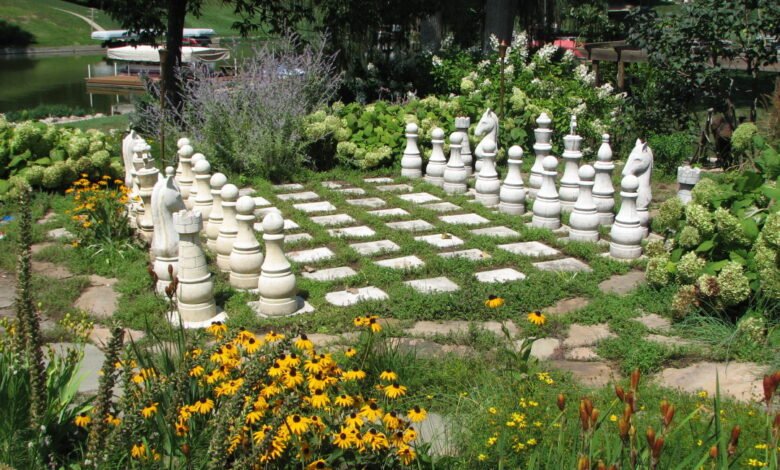Yard Art Landscaping: Transforming Outdoor Spaces with Creative Flair”

Yard art landscaping blends creativity and functionality, elevating outdoor spaces into vibrant, personalized environments. At its core, yard art refers to the use of decorative elements such as sculptures, fountains, planters, and lighting that enhance the aesthetic appeal of gardens, patios, and yards. This art form plays a crucial role in landscaping by adding focal points, creating themes, and offering a sense of personality to outdoor areas.
The growing trend of yard art in modern landscaping stems from homeowners’ desire to create unique spaces that reflect their tastes and lifestyle. Whether it’s a whimsical statue or a sophisticated water feature, the incorporation of yard art can transform any space into a creative oasis.
2. History and Evolution of Yard Art
The concept of Yard Art Landscaping dates back to ancient civilizations, where gardens served not only as functional spaces but also as expressions of culture and creativity. In ancient Rome and Greece, garden statues were commonplace, often depicting gods, mythical creatures, or important figures. These early forms of yard art were used to create a sense of grandeur and reflection.
As time progressed, yard art evolved through the Renaissance with an emphasis on symmetry and classical beauty. Moving into the 19th and 20th centuries, new materials and artistic movements introduced more abstract and contemporary designs. Today, yard art encompasses a wide range of styles, from traditional to avant-garde, reflecting the diverse tastes of modern homeowners.
3. Types of Yard Art
Yard art comes in many forms, each offering a distinct way to enhance your landscape. Here are some popular types of yard art:
- Sculptures and Statues: These are among the most classic forms of yard art, adding elegance or whimsy to any space. Sculptures can be made of metal, stone, wood, or concrete, representing animals, people, or abstract forms.
- Water Features: Fountains, ponds, and waterfalls not only provide visual appeal but also add soothing sounds to the garden. These features often serve as focal points.
- Outdoor Lighting: Strategically placed lights can highlight sculptures, pathways, and plants, creating ambiance after dark.
- Garden Ornaments: Items like wind chimes, sundials, or garden gnomes offer smaller decorative touches.
- Birdbaths and Feeders: These not only add charm to the garden but also attract wildlife.
- Planters and Pots: Using decorative planters allows you to integrate plants into the yard art design, turning pots into pieces of art themselves.
4. Materials Used in Yard Art
The materials used in yard art affect both its durability and appearance. Common materials include:
- Stone and Concrete: These durable materials are ideal for statues and large sculptures, offering weather resistance and a timeless look.
- Metal: Metals like copper, iron, and steel are used for both sculptures and functional pieces like planters or trellises. They offer a modern or rustic appearance depending on the finish.
- Wood: Wooden yard art adds a natural, organic feel to the garden. It can be treated to withstand the elements or left to weather for a more rustic look.
- Recycled Materials: Many homeowners are turning to eco-friendly options, repurposing everyday items like old tires, bottles, or metal scraps into unique yard art pieces.
5. Yard Art Styles and Themes
Yard art can align with different design styles, allowing you to create a cohesive look in your landscaping:
- Classical and Traditional Themes: Think Greco-Roman statues, formal fountains, and symmetrical designs.
- Modern and Minimalist: Sleek, abstract pieces made from metal or stone that provide a subtle, refined look.
- Whimsical and Artistic: Colorful, playful art pieces that add a sense of fun and personality to the space.
- Nature-Inspired: Yard art made from organic materials or representing natural forms, like animals, birds, or plants, blends seamlessly into the environment.
6. How to Choose the Right Yard Art
Choosing the right yard art requires careful consideration of your space, style, and budget. Some important factors include:
- Size and Space: Large sculptures may overwhelm small yards, while tiny ornaments might get lost in a large garden.
- Aesthetic Balance: Yard art should complement the overall landscape design. For example, a sleek modern sculpture might clash with a cottage garden.
- Functionality: Some yard art also serves a practical purpose, such as lighting, seating, or bird feeding.
- Budget: Yard art can vary greatly in cost, from affordable DIY options to high-end commissioned sculptures.
7. Popular Yard Art Trends
Current trends in yard art landscaping reflect a growing interest in sustainability, personalization, and technology:
- Eco-Friendly Yard Art: Using recycled or sustainable materials is increasingly popular, as more people seek to reduce their environmental impact.
- Interactive Yard Art: Pieces that engage the senses, such as kinetic sculptures or water features that invite touch and sound.
- LED and Lighted Yard Art: Lighting can be used not only for function but also to highlight art pieces and create dramatic effects after dark.
- Personalized Yard Art: Custom-designed pieces that reflect the homeowner’s unique personality or interests.
8. DIY Yard Art Landscaping Projects
For those who love to get hands-on with their landscaping, DIY yard art projects offer a fun and budget-friendly way to enhance outdoor spaces. Some ideas include:
- Upcycling Old Items: Repurpose old furniture, bicycle parts, or household items into yard art.
- Building Water Features: With some creativity, you can construct your own fountains or ponds using simple materials.
- Crafting Wooden Art: Simple woodworking projects like birdhouses, planters, or garden benches can be both functional and decorative.
- Creating Sculptures: Use metal scraps, stones, or even concrete to craft one-of-a-kind sculptures.


